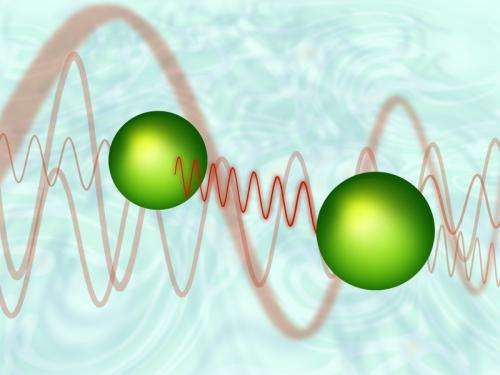Boosting the force of empty space

Vacuum fluctuations may be among the most counter-intuitive phenomena of quantum physics. Theorists from the Weizmann Institute (Rehovot, Israel) and the Vienna University of Technology propose a way to amplify their force.
Vacuum is not as empty as one might think. In fact, empty space is a bubbling soup of various virtual particles popping in and out of existence – a phenomenon called "vacuum fluctuations". Usually, such extremely short-lived particles remain completely unnoticed, but in certain cases vacuum forces can have a measurable effect. A team of researchers from the Weizmann Institute of Science (Rehovot, Israel) and the Vienna University of Technology has now proposed a method of amplifying these forces by several orders of magnitude using a transmission line, channelling virtual photons.
"Borrowing" Energy, but just for a Little While
If you park your car somewhere and later it is gone, that is most probably not due to vacuum fluctuations. Objects do not disappear or reappear, that would violate the law of energy conservation. In the world of quantum physics, however, things are a bit more complicated. "Due to the uncertainty principle, virtual particles can come into existence for a brief period of time", says Igor Mazets from the Vienna University of Technology. "The higher their energy, the faster they will disappear again."
But such virtual particles can have a measurable collective effect. At very short distances, vacuum fluctuations can lead to an attractive force between atoms or molecules – the Van der Waals forces. Even the ability of a gecko to climb flat surfaces can in part be attributed to vacuum fluctuations and virtual particles. The famous Casimir effect is another example of the power of the vacuum: The physicist Hendrik Casimir calculated in 1948 that two parallel mirrors in empty space will attract each other due to the way they influence the vacuum around them.
Atoms and Photons
Two atoms close to each other will also change the local vacuum around them. If one of them emits a virtual photon, which is almost instantly absorbed by the other, then on any timescale larger than the brief moment of the photon's existence, nothing much has happened – the total energy is conserved. But the fact that virtual particles can be exchanged modifies the vacuum around the atoms, and this leads to a force.
"Usually, such forces are very hard to measure", says Igor Mazets. "This is partly due to the fact, that such a photon may be emitted into any direction, and the chances of the second atom absorbing it are very small."
But what if the virtual particle has a little help to find its way? Ephraim Shahmoon, Gershon Kurizki (Weizmann Institute of Science) and Igor Mazets calculated what happens to vacuum forces between atoms when they are placed in the vicinity of an electrical transmission line such as a coaxial cable or a coplanar waveguide (a device used in cavity quantum electrodynamics experiments as an open transmission line), cooled to very low temperatures. "In that case, the fluctuations are effectively confined to one dimension", says Igor Mazets. The virtual particles will be forced to go into the direction of the other atom.
In that case, the fluctuation-mediated attraction between the atoms becomes orders of magnitude stronger than in free space. Usually, the force decreases rapidly with increasing distance between the atoms. Due to the transmission line, it falls off with one over the distance cubed, instead of one over the seventh power of the distance, as in the usual case.
The researchers believe that their proposed enhancement of the power of vacuum fluctuations can have profound implications for understanding Casimir- and Van der Waals forces and it may even be used for applications in quantum information processing and other emerging quantum technologies.
Provided by Medical University of Vienna


















